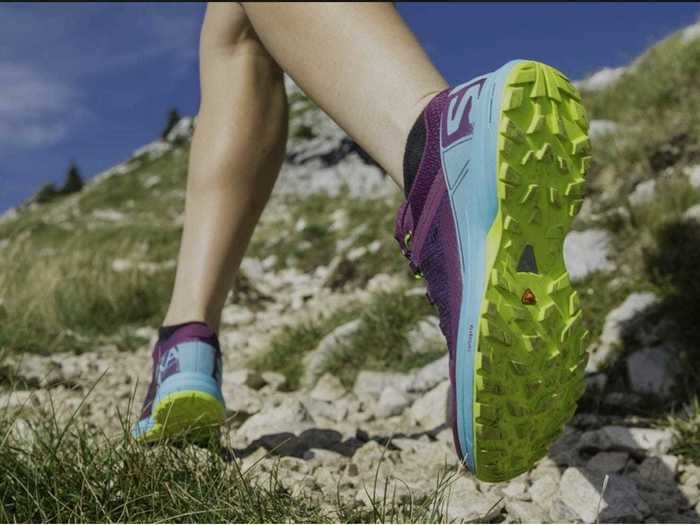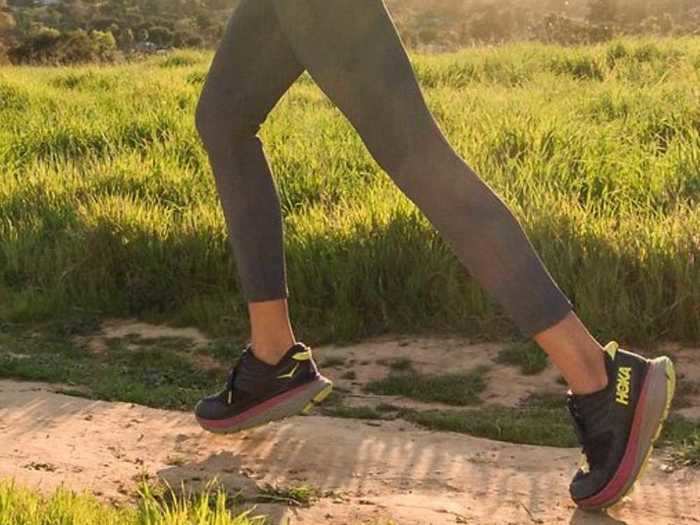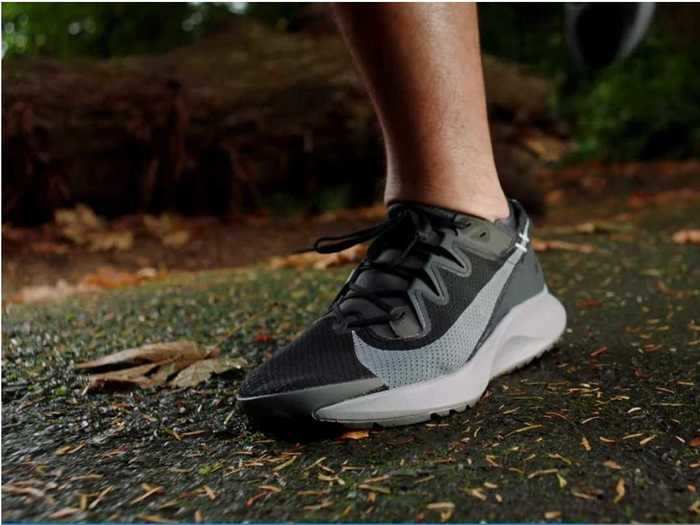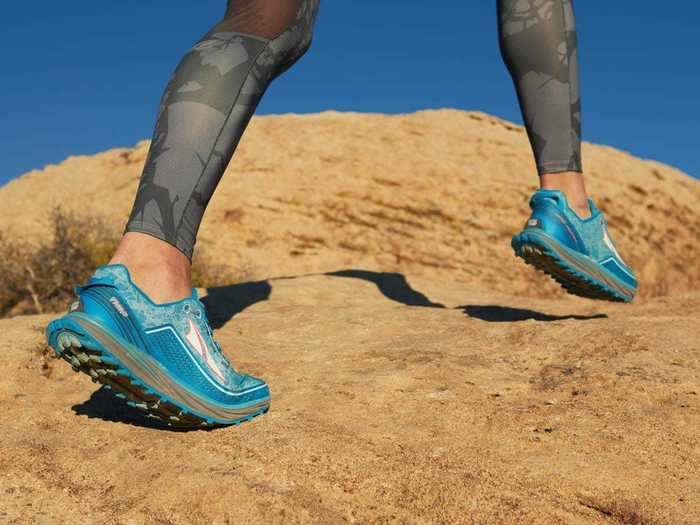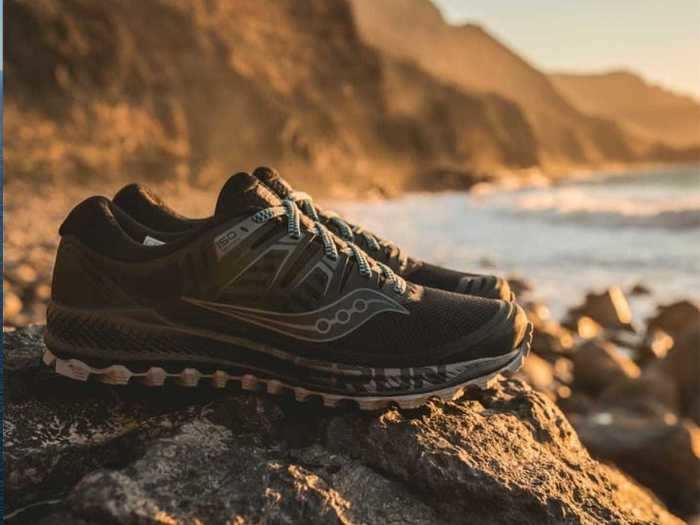- Trail running shoes keep your feet protected against rocks, roots, and the ever-changing terrain you'll find on backwoods jogs.
- Depending on the style of trail running you prefer, there are pairs perfect for racing, for keeping your feet dry in a downpour, and those that are designed to function on pavement as well as they are on the trail.
- Our top pick, the Salomon Sense Ride 3, is an impressive all-around, neutral trail shoe that fits like a glove and is built to last.
Trail running shoes are designed somewhere between a road running shoe and a hiking boot. They're made for moving fast but give you just the right amount of protection and support to help you leap over rocks, dodge roots, and plow through the mud without taking a spill.
Find the right set of trail shoes and take them on a gorgeous path through the woods and you'll have a running experience like no other. Pick the wrong ones, however, and you could be in for a rough ride.
How to shop for trail running shoesThere are many things to look for in a good trail shoe but the first question you should ask yourself is, where do you plan on using them? If your runs are on a combination of roads and trails, you'll want a hybrid shoe that won't slow you down on concrete while giving you enough grip on dirt to prevent you from sliding all over the place.
If you see yourself regularly running on wet, muddy trails, you'll want shoes with longer rubber lugs on their outsoles for better traction. You may even consider getting waterproof shoes made of Gore-Tex if you see a few river crossings in your running future.
When traversing difficult terrain, you may want a shoe with a reinforced toe cap to prevent sharp objects, such as sticks or branches, from piercing the front of your shoe. Also handy are shoes with rock plates, which are slabs of plastic or carbon fiber sandwiched between the midsole and the outsole of the shoe that shield your foot when running over jagged rocks.
What else to keep in mindOther features are more of a matter of taste. Do you want your trail shoes to have a pronounced drop? This means that the midsole is tilted forward with the heel higher than the toe portion of the shoe. Some runners feel having a heel-to-toe drop of 10 millimeters or more helps their running form by propelling them forward while the added rear foam protects their heels on bumpy trails.
Other runners, however, prefer zero drop shoes where the heel and ball of your foot are the same height off the ground. Shoes without drops are typically better for more technical trails and less likely to cause you to turn your ankle on steep, uneven terrain. Some runners even say zero drop shoes help them feel the trail better.
There's certainly plenty to consider, which is why we've field-tested a range of different trail shoes to help you find one fit for your running style.
Here are the best trail running shoes for men:
- Best trail running shoes overall: Salomon Sense Ride 3
- Best trail running shoes for races: Hoka One One Evo Speedgoat
- Best hybrid trail running shoes: Nike Pegasus Trail 2
- Best lightweight zero drop trail running shoes: Altra Timp 2.0
Updated on 7/21/2020 by Dan Havlik & Rick Stella: Added an entire new set of recommended trail running shoes and introduced new categories of best lightweight zero drop trail running shoes, best hybrid trail running shoes, and best trail running shoes for races, and updated the formatting throughout.
Best trail running shoes overall
Salomon
The
Salomon Sense Ride 3 does so much so well, it's hard to name one area as its greatest strength. And that's why the Sense Ride 3 is our favorite trail shoe overall since most runners will find something to like about it.
On one hand, this neutral, everyday trail trainer features some of the best protection and durability of all the shoes I tested. It handled everything I could throw at it during runs that took me over splintery logs, down wet embankments, and through a loose gravel field. After two months of testing the Sense Ride 3, they still looked as good as new and my feet were untouched.
The shoes performed well on a variety of trails from steep technical inclines to pure slop (it was a rainy spring) with Salomon's Contragrip MA outsole offering superb traction. The outsole's diamond-shaped rubber lugs are long enough at 2mm for climbing muddy hills but not so aggressive that they slowed me down or clogged up with dirt afterwards.
The Sense Ride 3s were the most comfortable of the shoes I tested, with a smooth contoured fit that seemed to swaddle my feet. There's an internal sleeve in the shoe, which Salomon calls EndoFit, that's designed to hug the foot and provide comfort. It delivered as did the molded OrthoLite insole that offered added cushioning.
The Sense Ride 3's welded, stitch-free upper is deluxe, producing a glove-like feel with no hotspots. It's also a gorgeous looking shoe, with a minimalist design that's not likely to go out of style.
Salmon's patented Quicklace system took a little getting used to, however. Featuring thin but strong laces that you pull tight via a sliding button, Quicklace lets you fine-tune the fit to get just the right amount of lace pressure.
The problem, for me, was that I couldn't figure out what to do with the dangling laces once I tightened the shoe. An illustration that came with the Sense Ride 3 was confusing, so I had to go online and find a short video from Salomon that reveals there's a hidden pocket on top of the tongue you're supposed to tuck the laces into. This worked fine but it was kind of a pain to do every time I laced up.
The Sense Ride 3s were heavier than I expected, with my size 11.5 pair weighing in at over 12 ounces per shoe. Part of that is because of the thicker midsole compared to previous versions. The added weight is worth it though because Salomon's plush Optivibe foam offered great energy return and a smooth ride while the shoe's rock plate added another layer of protection. The shoe has a moderate 8mm drop, which suited most conditions well.
Put plainly, the Sense Ride 3 is a great all-rounder on the trails.
Pros: Capable of handling a variety of terrain, outstanding protection and durability, very comfortable with a molded, glove-like fit, superb traction
Cons: Heavier than I expected, unique lacing system takes some getting used to
Best trail running shoes for races
Hoka One One
Hoka One One's Speedgoat line of trail shoes is named after legendary ultramarathoner Karl "Speedgoat" Meltzer who has more 100-mile race wins than any other runner. While the regular Speedgoat series from Hoka is designed for training, the lighter EVO version is made for going fast — and in my testing, theses EVOs were able to do just that.
If you know Hoka's popular Clifton series of road running shoes, which we named the best cushioned trainer for men, the EVO Speedgoat is a bit like a trail version of that highly stacked shoe.
There are quite a few key features that make the EVOs ideal for hitting the trails. For one, the EVO Speedcoat's upper is stitched with a lightweight but tough material called Matryx that blends stretchy Lycra with tough Kevlar for a durable, water-repellant shell. I loved putting on these shoes, too. Their bucket seat design and stretchy laces fit my feet (which suffer from some bunion issues) perfectly, with ample room in the toebox.
Because this is a Hoka shoe, the EVO's foam midsole is ample, to say the least. With a stack height of 32mm and a heel (31mm) to toe (27mm) drop of 4mm, these are tall, soft trail shoes designed with Hoka's slightly curved meta-rocker design. The extra cushioning provides a bigger buffer when running over bumpy terrain and I often felt like I was floating on a cloud in these shoes. There's almost no ground feel, however, which may not appeal to some runners. The only issue I had was on more technical trails with large rocks, where I often worried I'd turn an ankle (but didn't, thankfully).
What I liked most about the EVO Speedgoats is the speed. Weighing around ten ounces, these were one of the lightest shoes I tested and on less technical trails I'd flat out fly. Even when I was cruising along, I never felt I'd lose my footing thanks to the Vibram MegaGrip outsole, which features 5mm multidirectional lugs. Traction was superb and because the outsole extends in the back, the EVO Speegoats held their own when running downhill with the rear foam flare providing added stability.
As for the design, they feature a striking bright yellow and black colorway. The EVO Speedgoats are like the splashy sportscar of all the shoes I tested, but one built with the dependable all-wheel drive of a Subaru to help take you off the beaten path.
Pros: Light and fast, flashy design with a comfortable and durable fit, thick foam midsole will float you over rough terrain
Cons: Some stability issues on rocky, technical trails, high stack height reduces ground feel
Best hybrid trail running shoes
REI
The
Nike Pegasus Trail 2, as its name suggests, is the trail version of the popular Nike Pegasus road shoe line. And while the Trail 2 borrows a few things from its road warrior brother, it's designed to get down and dirty, making it a unique hybrid shoe you'll be comfortable using on everything from asphalt to mud.
The main similarity between the Pegasus Trail 2 and the Pegasus 37 (the road version) is the large chunk of Nike's React foam, which forms the midsole of both models. React is a soft but responsive foam which I've liked on Nike's previous road shoes and it's a great match for the Trail 2's city-to-trail design.
On one of my first runs in this shoe, I ran roughly a mile on the roads to a local park and then sped off down a winding, tree-lined path for a few more miles on soft ground before returning to the pavement to head home. This might not seem like a big deal but if you've ever tried to bring a serious trail shoe on the road – or a road shoe on the trails, for that matter – it's not fun. The Trail 2 handled both surfaces well, though its mountain bike-inspired rubber outsole with 2mm lugs thrives in the dirt.
The Trail 2 has a stack height of 31mm in the heel and 21mm in the forefoot for a drop of 10mm. That significant drop did help generate forward momentum and I enjoyed being able to put the pedal to the metal with these shoes, particularly on lower-grade downhills.
As with other highly stacked trail shoes, I experienced some instability on steeper, more treacherous trails, particularly those lined with large rocks. This was particularly true when my legs were tired, which caused the shoes to feel wobbly. On the plus side, the generous amount of foam reduced the stress on my legs during longer runs.
I also liked the Pegasus Trail 2's functional design elements including a faux gaiter on the heel collar that prevented dirt and debris from getting inside the shoe. The tough but breathable engineered mesh on the Trail 2's upper was also a nice touch as was the water-repellant coating on the gusseted tongue and collar that prevented moisture from creeping in.
In terms of looks, the Pegasus Trail 2 is an eye-catching shoe. The pair I tested had a brash but appealing color scheme of pale yellow on the upper, neon green around the laces and heel counter, and teal on the neoprene tongue and collar. The shoe's forefoot includes two toe fangs, which are a pair of rubber nubs that add traction when running uphill and look plain fierce.
The Trail 2's were the heaviest shoes I tested (over 12 ounces in size 11.5) and while I wasn't keen on that, a few of my fastest and most enjoyable runs were in them. These shoes perform extremely well both on and off the roads.
Pros: A great commuter shoe that can handle both pavement and dirt, Nike's React foam midsole provided ample cushioning, many highly functional and attractive design elements
Cons: A very heavy shoe, steep heel to toe drop caused some stability issues, couldn't get a full locked down fit
Best lightweight zero drop trail running shoes
Altra/Facebook
If you want to really feel the trail on your runs, go with a shoe with a zero drop design (i.e. where both the heel and the forefoot are the same height off the ground). The best zero drop shoe I tested was the lightweight but well cushioned Altra Timp 2.0.
Altra's Timp line is a relatively new but beloved series of shoes, and to say that the 2.0 version has divided Timp devotees would be an understatement. The biggest change between Timp 2.0 and Timp 1.5 is the fit, which on the new version is tighter through the mid- and forefoot. In a word, these shoes feel snug. That's somewhat unusual for Altra since the company has a reputation for creating shoes with a wide toebox that lets you splay out your toes in a way that mimics barefoot walking. You can still do that with the Timp 2.0, but everywhere else feels narrower.
The shoe has also been trimmed down and shedded some weight. In my size 11.5s, each Timp 2.0 weighed around 10 ounces, which is equal to the speedy Hoka EVO Speedgoats above. These felt even lighter than the Speedgoats though and, overall, I loved the sleek and fast 2.0, which would make a decent racing shoe.
They do require some breaking in, however. When I initially put them on, my troublesome right foot with its bunion issue, felt squeezed. After loosening the laces a bit and taking them on a few tempo runs, I was hooked.
Though it's a zero drop shoe, the Timp 2.0 does has significant cushioning with a stack height of around 30mm. Altra uses its Quantic foam – a first for the Timp line – on the 2.0 and its plush but lightweight midsole felt fantastic even on bumpy trails. The Maxtrac outsole provided decent grip and while the rubber lugs are on the small size (2mm), Altra deploys them in its Trailclaw outlay, which positions them beneath your foot's metatarsals to provide better traction at toe off. These weren't my favorite shoes for wet and muddy conditions, but they certainly held their own on just about everything else.
Overall, I enjoyed the sensation of running in the Timp 2.0s. While zero drop shoes aren't for everyone, they do provide an experience more akin to running barefoot. When I padded over rocks or went sideways on steep embankments, I never felt unstable. I could just run, which is what it's all about.
Pros: A sleek and fast zero drop shoe that felt natural to run in, significantly lighter than previous version, Quantic foam midsole provide excellent cushioning
Cons: Narrower fit overall might not appeal to previous Timp fans, shoes require a fair amount of breaking in
Best waterproof trail running shoes
Saucony/Facebook
If the trails you plan to run on are wet, muddy, and full of river crossings, the best shoe to go with is the
Saucony Peregrine 10 GTX which features an upper made from waterproof Gore-Tex. But the Peregrine 10 GTXs aren't only suited for the trails because they'll keep your feet dry, they're excellent all-around off-road shoes and feature the best grip of the models I tested.
The Saucony Peregrine 10 GTX is a low-to-the-ground shoe with a minimal heel (22mm) to forefoot (18mm) drop of 4mm. This is another shoe that helps you feel the trail, minus the jolts since they're well protected. I had no stability issues with the Peregrine 10 GTX and plowed through a variety of terrain in them with confidence, including ankle-deep muck, piles of slippery wet leaves, and a small stream.
The one knock against Gore-Tex is that it can cause a shoe's upper to feel stiff and confining. I had no such problem with the Peregrine 10 GTX, which fit my feet like a comfortable glove. The Gore-Tex upper was less supple than some of the other shoes I tested and didn't breathe as well – you'll definitely want to air these out after your runs – but I barely noticed it once I hit the trails.
What I did notice was the superior traction from Saucony's PWRTRAC outsole, which uses a sticky rubber compound and an aggressive, 6mm hexagonal lug pattern that kept me from slipping even on a rainy run through a field. On the downside, this is definitely not a shoe you'd want to use on the roads and the grippy outsole tended to retain some dirt after trail runs.
The Peregrine 10 GTX is well cushioned and there's a rock plate to protect your feet from sharp objects on the trail. Saucony's FORMFIT design with its reinforced upper cradled my feet snugly if a bit too tightly on my slightly longer right foot. In the past, I've had issues with stiff heel cups causing me pain in my right heel after runs and this was the case with the Peregrine 10 GTX. After doing some research, I noticed at least one other reviewer had the same problem with the Peregrine 10, so you might want to consider going up half a size if this is an issue for you.
Other than that, my only other issue was weight. In size 11.5, the Peregrine 10 GTX tipped the scales at over 12 ounces, putting it amongst the heavier shoes I tested. When you consider what you're getting with this fully featured trail shoe, however, including the waterproof benefits of Gore-Tex, those extra few ounces are worth it.
Pros: Gore-Tex upper keeps your feet dry even when crossing streams, excellent traction from an aggressive 6mm lug pattern on the outsole, low-to-the ground profile provided excellent stability
Cons: Snug fit caused me some heel pain after runs, bottom of shoe retains dirt, quite heavy

